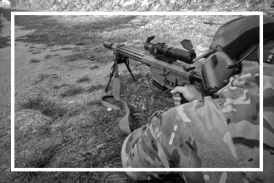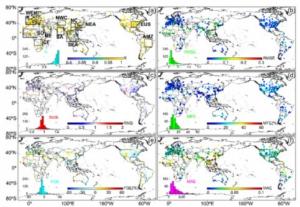Boosting accuracy in aerosol mapping via BRDF comparison
FAYETTEVILLE, GA, UNITED STATES, July 1, 2025 /EINPresswire.com/ -- A new study improves satellite-based aerosol measurements by assessing how different surface reflection models impact inversion accuracy. By comparing the Ross Li and Rahman–Pinty–Verstraete (RPV) models within a widely used retrieval algorithm, researchers reveal region-specific biases and highlight key uncertainties—particularly in fine-mode aerosol components.
Satellite remote sensing plays a critical role in monitoring aerosol optical properties, which influence climate, air quality, and human health. However, retrieving these properties accurately is complicated by land surface reflections, which often dominate the signal captured by sensors. Traditional models, such as the Lambertian approximation, oversimplify surface behavior and introduce systematic errors. More realistic bidirectional reflectance distribution function (BRDF) models have been developed to account for these complexities. Among them, the Ross_Li and Rahman–Pinty–Verstraete (RPV) models are widely used. Yet, their comparative performance and impact on aerosol data inversion remain underexplored. Due to these issues, a detailed comparative study of BRDF model-induced uncertainties is urgently needed.
On June 4, 2025, a research team from the Chinese Academy of Meteorological Sciences published a study (DOI: 10.34133/remotesensing.0637) in Journal of Remote Sensing that sheds new light on the uncertainties inherent in satellite aerosol data. The study investigates how two commonly used surface reflectance models—Ross_Li and RPV—affect the retrieval of aerosol optical properties when used within the Generalized Retrieval of Aerosol and Surface Properties (GRASP) /Component algorithm. By identifying where and how these models diverge, the research provides critical insight into improving global aerosol monitoring systems, particularly over complex land surfaces.
The researchers applied both the Ross_Li and RPV BRDF models to retrieve aerosol properties—including aerosol optical depth (AOD), fine- and coarse-mode AOD, absorbing AOD, and Ångström exponents—from global satellite data. They found that while AOD and related metrics were broadly consistent, fine-mode AOD retrievals exhibited higher sensitivity to the model choice. The Ross_Li model generally underestimated fine aerosols compared to RPV, while coarse-mode estimates were slightly inflated. Notably, the uncertainty in overall AOD estimates was largely traced back to discrepancies in fine-mode AOD. Absorbing aerosol parameters showed greater variability, with region-specific biases in North Africa, the Middle East, and East Asia. The findings underscore the importance of BRDF model selection in refining aerosol retrieval accuracy.
Using the GRASP/Component algorithm, the team processed multi-angle satellite observations from the POLDER-3/PARASOL platform, covering diverse land surfaces and aerosol regimes. Both Ross_Li—a linear kernel-driven model—and RPV—a semi-empirical, nonlinear model—were applied to generate inversion results for multiple aerosol parameters at key wavelengths (e.g., 565 nm for AOD, 443/865 nm for Ångström exponents). The study utilized a large dataset from AErosol RObotic NETwork (AERONET) sites globally and conducted intercomparisons using statistical metrics such as root mean square error (RMSE), relative mean bias (RMB), and mean fractional error (MFE). AOD retrievals using both models showed strong correlation (R > 0.98) but regional discrepancies emerged: Ross_Li slightly underestimated AOD in East Asia and North America, while RPV yielded higher absorbing AOD (AAOD) values in southern Europe and western North America. SSA results were more scattered, with higher RMSE but lower MFE due to large absolute values. The largest divergence appeared in absorbing Ångström exponent (AAE) values, suggesting that absorption-related parameters are more sensitive to surface model assumptions. This comprehensive, quantitative comparison offers new clarity on how model selection affects aerosol optical inversion performance.
“Our results highlight that even subtle differences in surface reflectance modeling can cascade into significant uncertainties in aerosol estimates,” said lead author Haoling Zhang. “Understanding these effects allows us to better interpret remote sensing data and paves the way for improved retrieval algorithms that can more reliably support air quality and climate assessments.”
The study employed the GRASP/Component inversion algorithm, which retrieves aerosol properties by simultaneously solving for surface reflectance and atmospheric parameters. POLDER-3 data provided the spectral and angular reflectance inputs, while Ross_Li and RPV models represented alternative surface reflection schemes. Aerosol retrievals were validated using AERONET ground station data, and statistical comparisons quantified discrepancies. The team focused on 12 global regions representing varied aerosol conditions to ensure robust spatial analysis.
This research offers a framework for improving satellite aerosol retrieval by addressing a critical yet underexamined source of uncertainty—surface reflectance modeling. Future work may extend this analysis to dynamic surface conditions, such as snow or vegetation seasonality, and integrate additional BRDF models. Ultimately, refining these algorithms could significantly enhance the reliability of aerosol datasets used in forecasting, climate modeling, and global health assessments, especially in regions where ground-based validation is sparse.
References
DOI
10.34133/remotesensing.0637
Original Source URL
https://spj.science.org/doi/10.34133/remotesensing.0637
Funding Information
This work was supported by the National Natural Science Foundation of China (42275195, 42375188) and Youth Innovation Team of China Meteorological Administration (CMA2024QN13).
Lucy Wang
BioDesign Research
email us here
Legal Disclaimer:
EIN Presswire provides this news content "as is" without warranty of any kind. We do not accept any responsibility or liability for the accuracy, content, images, videos, licenses, completeness, legality, or reliability of the information contained in this article. If you have any complaints or copyright issues related to this article, kindly contact the author above.
Remembering Pamela Prince-Eason: Statement from Javier Palomarez, USHBC
Expert Panel to Discuss Corrosion Control Trends in India’s Water and Wastewater Sectors
JM Nutrition Servicing Oakville and Burlington Area
Więcej ważnych informacji
 Jedynka Newserii
Jedynka Newserii

 Jedynka Newserii
Jedynka Newserii

Polityka

Unijne mechanizmy ułatwiają zwiększenie wydatków na obronność przez europejskie kraje NATO. Ważnym aspektem infrastruktura podwójnego zastosowania
Wydatki na obronność w krajach NATO mają wzrosnąć do 2035 roku do 5 proc. PKB. W dużej mierze będzie to możliwe dzięki Unii Europejskiej, która stworzyła ramy umożliwiające krajom członkowskim realizację celów NATO w zakresie obronności, nie tylko poprzez finansowanie i inwestycje, ale także poprzez elastyczność budżetową. – To pełna synergia, można powiedzieć, że Unia Europejska współfinansuje razem z państwami członkowskimi cele zdolnościowe NATO – ocenia Paweł Zalewski, sekretarz stanu w Ministerstwie Obrony Narodowej.
Ochrona środowiska
Rusza budowa lądowej infrastruktury dla projektów Bałtyk 2 i Bałtyk 3. Prąd z tych farm wiatrowych popłynie w 2027 roku

Ruszyła budowa lądowej infrastruktury dla morskich farm wiatrowych Bałtyk 2 i Bałtyk 3 rozwijanych przez Equinor i Grupę Polenergia. To przede wszystkim baza serwisowa w Łebie i dwie stacje elektroenergetyczne. Jednocześnie trwają przygotowania do rozpoczęcia prac na morzu. Pierwszy prąd z obu projektów popłynie w 2027 roku, a w kolejce czeka morska farma wiatrowa Bałtyk 1 – największy i najbardziej zaawansowany projekt II fazy rozwoju offshore.
Edukacja
Uczelnie zaczynają wspólnie walczyć ze zjawiskiem mobbingu i dyskryminacji. Ruszają badania nad skalą problemu

Szkoły wyższe chcą aktywniej walczyć ze zjawiskiem mobbingu i dyskryminacji zarówno wobec pracowników, jak i studentów. W ramach projektu Bezpieczna Uczelnia będą się wymieniać dobrymi praktykami w zakresie polityki antymobbingowej. Zostaną przeprowadzone także badania na temat obecnej sytuacji w środowisku akademickim. Dotychczasowe badania prowadzone przez Fundację Science Watch Polska wskazują, że mobbing to dość powszechne zjawisko na uczelniach, które przybiera charakterystyczne dla środowiska formy.
Partner serwisu
Szkolenia

Akademia Newserii
Akademia Newserii to projekt, w ramach którego najlepsi polscy dziennikarze biznesowi, giełdowi oraz lifestylowi, a także szkoleniowcy z wieloletnim doświadczeniem dzielą się swoją wiedzą nt. pracy z mediami.








.gif)

 |
| |
| |
|